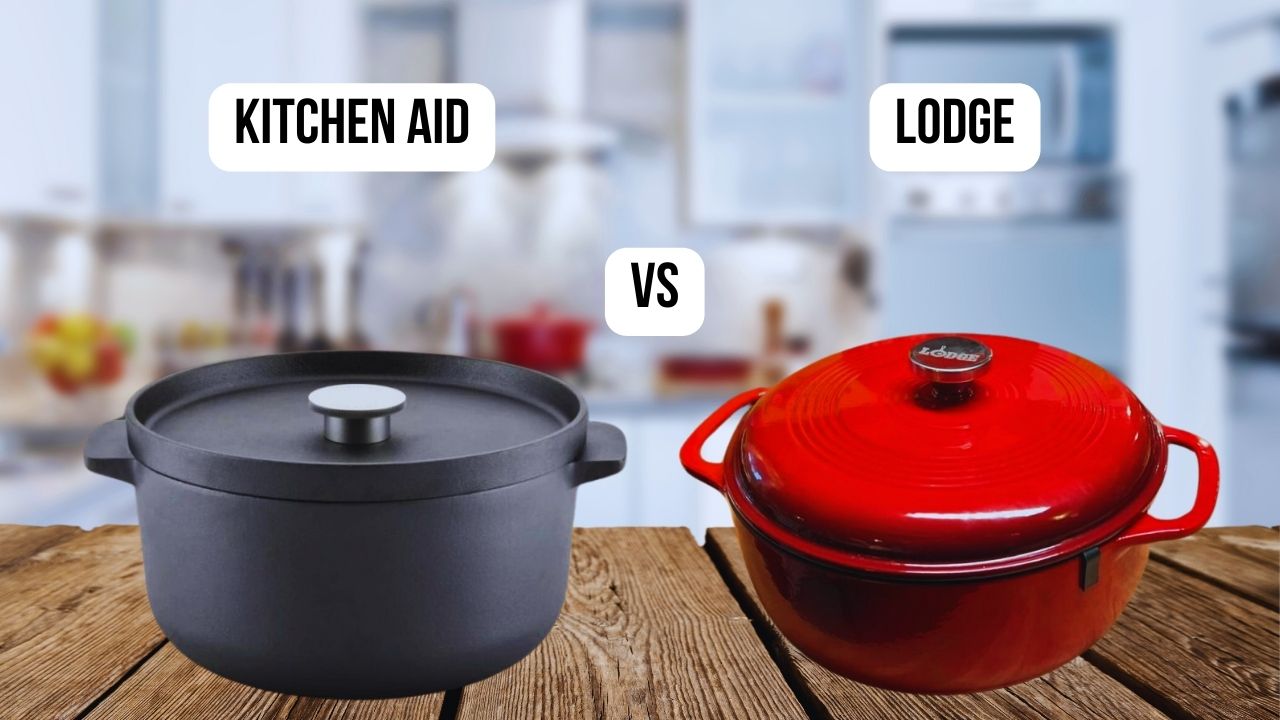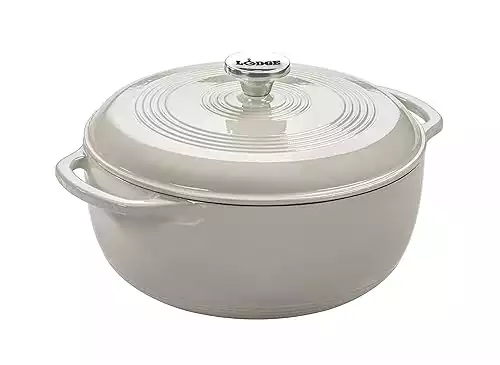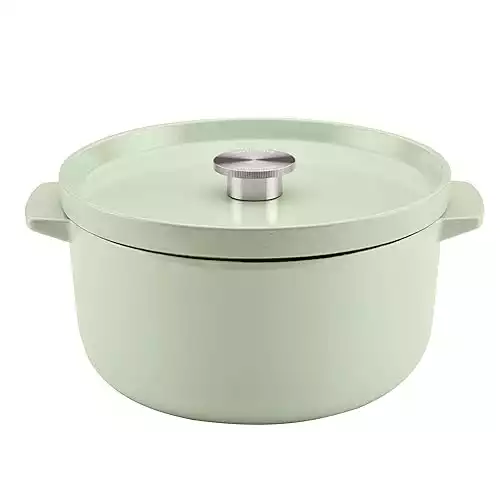As a seasoned restaurant chef with over a decade of experience, I’ve spent considerable time exploring the best tools for our kitchen. My latest endeavor has been to find the ideal Dutch oven, a staple for both home cooks and professional chefs. After months of testing various models, I’m ready to share my findings. In this comparison, we’ll look closely at the Lodge Cast Iron Dutch Oven and the KitchenAid Dutch Oven. We’ll evaluate these based on crucial aspects such as:
- Material
- Weight
- Heat retention and compatibility
- Lid fit
- Handles and product design
- Colors
- Maintenance and cleaning
- Durability and performance
- Warranty
- Price
|
Our Rating:
4.0
|
Our Rating:
3.1
|
|
Pros:
|
Pros:
|
|
Cons:
|
Cons:
|
- High-quality cast iron
- Excel in heat retention
- Lid fits snugly
- Dual handles that provide a secure grip
- Boast sturdiness and longevity
- Lifetime warranty
- Cost-effective option
- Tends to be hefty
- Special care against rust is required
- Weight is manageable
- Good heat retention capabilities
- More affordable
- Worse material
- Minor issue with lid stability
- Handles lack secure grip holes
- The enamel may become chipped
- Less robust and substantial compared to premium options
- One-year warranty
The Lodge Dutch Oven is a well-known and trusted name in the cookware industry. Crafted with a rich history dating back to 1896, Lodge has gained a reputation for producing high-quality, durable cookware favored by home cooks and professional chefs alike.
KitchenAid is a renowned kitchen appliance brand known for its premium-quality products. Their Enameled Cast Iron Dutch Oven is a popular choice for cooking enthusiasts. This Dutch oven offers functionality and aesthetic appeal, making it a trusted brand for culinary enthusiasts and home chefs.
Despite not making it to the TOP-5 best Dutch ovens list for a few reasons, these two Dutch ovens are still excellent choices.
This review aims to provide you with clear insights, helping you decide which Dutch oven best suits your cooking needs. Let’s dive into the details of each model.
In this review, I provide an independent assessment of the pros and cons of Lodge and KitchenAid, based on my experience as a chef. If you choose to purchase it, please consider using the referral links included in this article. I earn a small commission from your purchases at no additional cost to you, which helps support this blog. Thank you!
Lodge VS KitchenAid: Material
| Lodge | KitchenAid |
|---|---|
| The Lodge Cast Iron Dutch Oven is constructed from high-quality cast iron. It’s seasoned with vegetable oil, making it naturally non-stick over time. | The KitchenAid Dutch oven is made of cast iron with an enamel coating. It offers a robust and rust-resistant build. However, I find its cast iron thickness slightly less substantial than other Dutch oven brands. |
Lodge VS KitchenAid: Weight
| Lodge | KitchenAid |
|---|---|
| Lodge‘s cast iron cookware tends to be hefty, which can be challenging for some users. Its weight may not suit those seeking a lighter option. | This Dutch oven‘s weight is manageable. It can be easily lifted and maneuvered even if loaded with food. |
Lodge VS KitchenAid: Heat Retention and Compatibility
| Lodge | KitchenAid |
|---|---|
| Lodge Dutch Ovens excel in heat retention and are compatible with various heat sources, including stovetops, ovens, and even open flames. | The KitchenAid Dutch oven demonstrated good heat retention capabilities, maintaining a consistent temperature during braising for optimal results. Additionally, its wide heat compatibility, suitable for various stovetops and oven use up to 500 degrees Fahrenheit, ensures versatility in cooking methods. |
Lodge VS KitchenAid: Lid Fit
| Lodge | KitchenAid |
|---|---|
| The Lodge Dutch Oven‘s lid fits snugly, ensuring a tight seal that locks in moisture and flavor during cooking, resulting in delicious, tender dishes. | The self-basting lid creates an effective seal to retain moisture and flavor in the Dutch oven. However, there’s a minor issue with lid stability, causing steam leakage when the pot is moved, especially during extended cooking sessions. |
Lodge VS KitchenAid: Handles and Product Design
| Lodge | KitchenAid |
|---|---|
| Its dual handles provide a secure grip, and the sturdy design is both functional and classic. The ergonomic design makes it easy for me to lift and maneuver it even when it is full. | The Dutch oven‘s side handles lack secure grip holes, making it challenging to hold firmly. Despite this, the overall design is elegant and minimalistic, making it visually appealing for serving dishes. |
Lodge VS KitchenAid: Colors
| Lodge | KitchenAid |
|---|---|
| Lodge Cast Iron Dutch Ovens typically come in a classic black finish. If you like to get the Lodge Enameled Cast Iron Dutch Oven, there are various hues to select from, including red, blue, white, and green. | The KitchenAid Enameled Cast Iron Dutch Oven is available in a few color options, such as pistachio and blue velvet. The color choices are relatively limited compared to other Dutch ovens that offer a more extensive selection of shapes, sizes, and colors. |
Lodge VS KitchenAid: Maintenance and Cleaning
| Lodge | KitchenAid |
|---|---|
| The Lodge Cast Iron Dutch Ovens require some maintenance, such as periodic re-seasoning, but are relatively easy to clean and maintain. After each usage, I usually rinse it with hot water and scrub it mildly. To avoid rust, avoid using soap and be sure to dry it properly. With diligent maintenance, it naturally develops a non-stick seasoning over time. | Cleaning the KitchenAid Dutch oven is easy due to its enamel coating, but it displayed signs of chipping after a few uses. |
Lodge VS KitchenAid: Durability and Performance
| Lodge | KitchenAid |
|---|---|
| Lodge Dutch Ovens are sturdy and are renowned for their longevity and exceptional cooking performance. These Dutch ovens can last for generations when cared for appropriately. | The KitchenAid Dutch oven performed adequately for a specific cooking task but felt less robust and substantial compared to premium options. It’s suitable for occasional home use but may not be as durable for professional kitchen demands. |
Lodge VS KitchenAid: Warranty
| Lodge | KitchenAid |
|---|---|
| Lodge offers a lifetime warranty for their Dutch ovens. This extensive warranty makes me confident in the longevity of their products. | This Dutch oven includes a one-year warranty for added reassurance regarding its durability. Nevertheless, it is best to invest in high-end brands that offer better value for the price. |
Lodge VS KitchenAid: Price
| Lodge | KitchenAid |
|---|---|
| Lodge Cast Iron Dutch Ovens are reasonably priced for their quality construction and excellent cooking performance. I can confidently say that my Lodge Dutch Oven gave me my money’s worth. | The KitchenAid Dutch Oven is affordable. |
Cooking Test
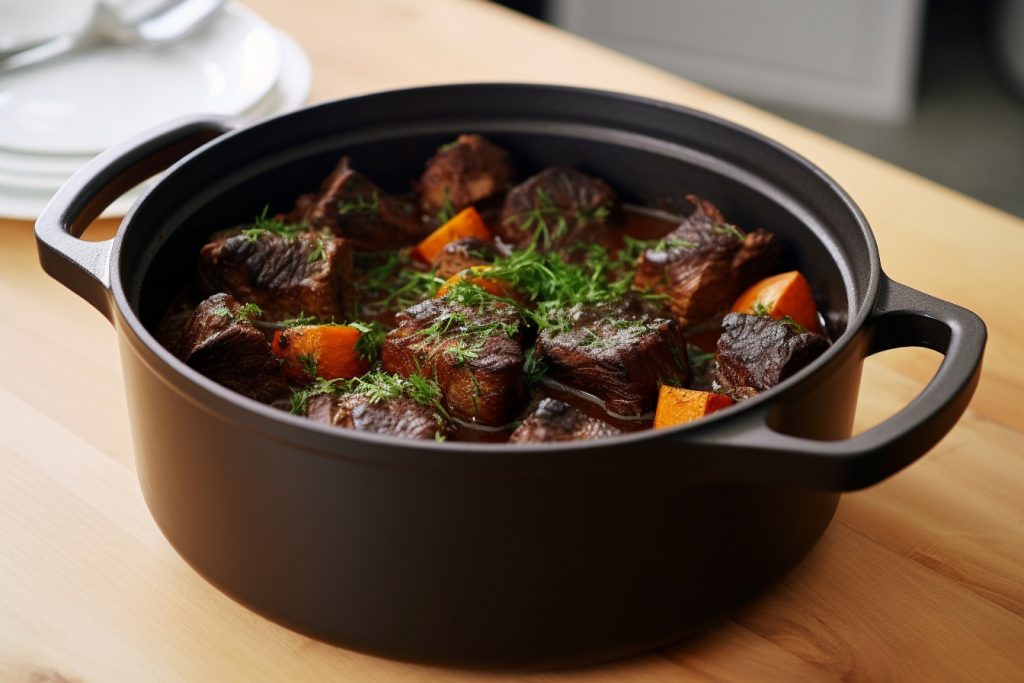
I did a cooking test between the KitchenAid and Lodge Dutch ovens by preparing Red Wine Braised Short Ribs. The following parameters were considered to determine their performance:
Browning

The KitchenAid and Lodge Dutch ovens both exhibited impressive abilities for browning. Thanks to their cast iron construction, they achieved an ideal sear on every side of the short ribs, forming a deeply caramelized crust that enhanced the overall depth and complexity of the flavor in the dish.
Moisture Retention
The Lodge Dutch Oven demonstrated excellent moisture retention. Its tight-fitting lid and cast iron construction ensured that the natural juices and liquids were effectively trapped within the pot, which resulted in tender and succulent short ribs.
On the other hand, a minor steam leak is observed in KitchenAid Dutch Oven. While it is not a significant flaw, the short ribs from Mueller Dutch Oven turned out to be more tender.
Final Flavor
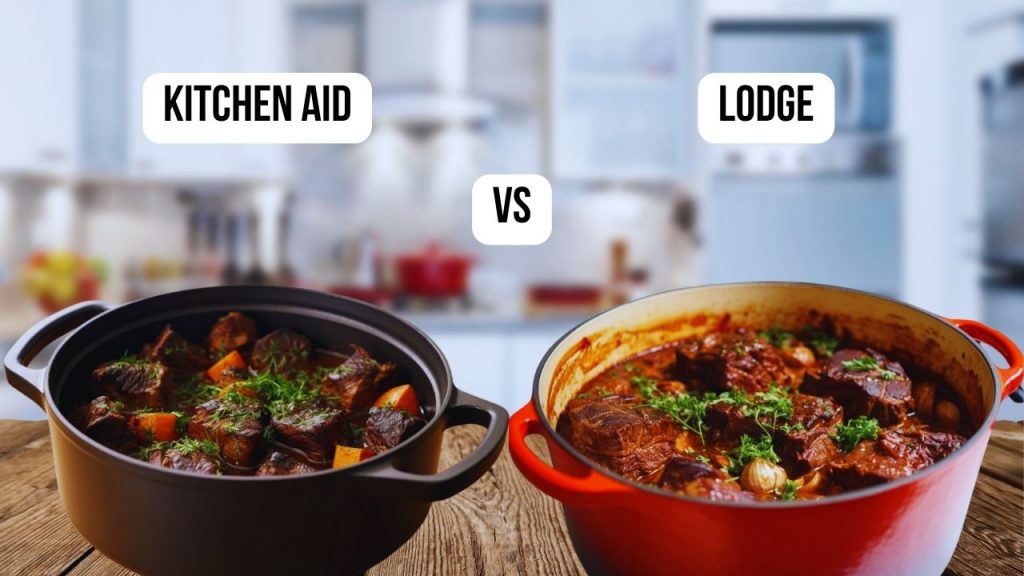
Although the Red Wine Braised Short Ribs turned out remarkably flavorful in both Dutch ovens, the ribs prepared in the Lodge Dutch Oven were notably more tender and had a richer taste.
How We Tested
The test was designed to rigorously compare the performance of both Dutch ovens under actual cooking conditions.
Initially, we placed the KitchenAid and Lodge Dutch ovens adjacent to each other on the stovetop, heating them to the necessary temperature. We then proceeded to brown short ribs in each oven, carefully noting their heat distribution efficiency and how well they seared the meat, contributing to its flavor.
Throughout the slow-cooking process, we closely observed how well each Dutch oven retained moisture, focusing particularly on the effectiveness of their lids in maintaining the required steam and moisture levels for the dish.
After the cooking period concluded, we performed a detailed taste analysis. This included assessing the tenderness, flavor, and overall culinary quality of the Red Wine Braised Short Ribs cooked in each Dutch oven.
Conclusion: Lodge is The Winner
|
Our Rating:
4.0
|
Our Rating:
3.1
|
|
Pros:
|
Pros:
|
|
Cons:
|
Cons:
|
- High-quality cast iron
- Excel in heat retention
- Lid fits snugly
- Dual handles that provide a secure grip
- Boast sturdiness and longevity
- Lifetime warranty
- Cost-effective option
- Tends to be hefty
- Special care against rust is required
- Weight is manageable
- Good heat retention capabilities
- More affordable
- Worse material
- Minor issue with lid stability
- Handles lack secure grip holes
- The enamel may become chipped
- Less robust and substantial compared to premium options
- One-year warranty
In conclusion, after an extensive evaluation encompassing several key factors, the Lodge Cast Iron Dutch Oven emerges as the clear winner in this comparison against the KitchenAid Dutch Oven. As a chef with more than ten years of experience, I have found that the Lodge Dutch Oven excels in crucial areas like heat retention, durability, and overall cooking performance.
While the KitchenAid Dutch Oven performed admirably, especially in browning and providing an aesthetically pleasing design, it falls slightly short in aspects like moisture retention and long-term durability. The minor issue with steam leakage during prolonged cooking sessions also points to a slight disadvantage in its design.
On the other hand, the Lodge Dutch Oven displayed superior moisture retention, thanks to its well-fitting lid, and its cast iron construction ensured excellent heat distribution. This was evident in the cooking test where the Lodge oven produced short ribs that were not only flavorful but also more tender, showcasing its superior cooking capabilities.
Furthermore, the Lodge oven’s robust build, coupled with a lifetime warranty, underscores its reliability and value for money, making it a worthwhile investment for both home cooks and professional chefs.
In summary, based on my comprehensive testing and experience, I recommend the Lodge Cast Iron Dutch Oven as the top choice for anyone seeking a high-quality, durable, and efficient Dutch oven. It stands out not just for its cooking prowess but also for its ability to withstand the rigors of regular kitchen use, truly living up to its reputation in the cookware industry.
However, if you are looking for an affordable Dutch oven for home cooking, then, Lodge might be a good option for you. If you decide to purchase it, please use my referral link.
Chef Bradley Thompson highly recommends to check his list of the best Dutch ovens.

